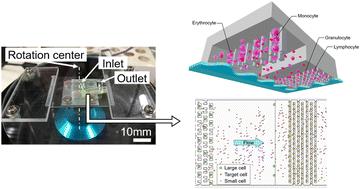Our official English website, www.x-mol.net, welcomes your
feedback! (Note: you will need to create a separate account there.)
A novel microfluidic chip for on-site radiation risk evaluation
Analyst ( IF 3.6 ) Pub Date : 2024-11-20 , DOI: 10.1039/d4an00941j Kenta Takahashi, Takahiro Tamura, Kosuke Yamada, Kaisei Suga, Yuri Aoki, Ryota Sano, Kentaro Koyama, Asako J. Nakamura, Takaaki Suzuki
Analyst ( IF 3.6 ) Pub Date : 2024-11-20 , DOI: 10.1039/d4an00941j Kenta Takahashi, Takahiro Tamura, Kosuke Yamada, Kaisei Suga, Yuri Aoki, Ryota Sano, Kentaro Koyama, Asako J. Nakamura, Takaaki Suzuki

|
This paper proposes a microfluidic chip for on-site radiation risk evaluation using immunofluorescence staining for the DNA double-strand break (DSB) marker phosphorylated histone, H2AX (γ-H2AX). The proposed microfluidic chip separates lymphocytes, the cells of the DNA DSB evaluation target, from whole blood based on their size and traps them in the trap structure. The subsequent DNA DSB evaluation, γ-H2AX assay, can be performed on a chip, which saves space and simplifies the complicated operation of the assay, which conventionally requires a large experimental space. Therefore, this chip will enable the biological effect evaluation of radiation exposure to be completed on-site. Bead experiments with samples containing 10 μm and 27 μm diameter beads showed that the proposed chip introduced the sample into the flow channel only by centrifugal force and passively separated the two types of beads by the structure in the flow channel. In addition, bead experiments showed that isolated 10 μm diameter beads were trapped in more than 95% of the 1000 lymphocyte trap structures (LTSs). The feasibility of the proposed method for on-site radiation risk evaluation was demonstrated through cell-based experiments by performing the γ-H2AX assay in human lymphoblastoid TK6 cells. The experiment shows that LTSs in the flow channel are capable of trapping TK6 cells, and γ-H2AX foci which are markers of DNA DSBs are observed in the TK6 cells on the chip. Thus, the results suggest that the proposed microfluidic chip simplifies the γ-H2AX assay protocol and provides a novel method to perform the assay on-site, which is conventionally impracticable.
中文翻译:

用于现场辐射风险评估的新型微流控芯片
本文提出了一种微流控芯片,用于使用 DNA 双链断裂 (DSB) 标记物磷酸化组蛋白 H2AX (γ-H2AX) 的免疫荧光染色进行现场辐射风险评估。拟议的微流控芯片根据淋巴细胞的大小从全血中分离出淋巴细胞,即 DNA DSB 评估靶标的细胞,并将它们捕获在陷阱结构中。随后的 DNA DSB 评估,即 γ-H2AX 检测,可以在芯片上进行,这节省了空间并简化了传统的大实验空间的复杂检测操作。因此,该芯片将使辐射暴露的生物效应评估能够在现场完成。对含有直径为 10 μm 和 27 μm 的微珠的样品进行的微珠实验表明,所提出的芯片仅通过离心力将样品引入流道,并通过流道中的结构被动分离两种类型的微珠。此外,磁珠实验表明,分离的 10 μm 直径磁珠被捕获在 1000 个淋巴细胞陷阱结构 (LTS) 中的 95% 以上。通过在人淋巴母细胞样 TK6 细胞中进行 γ-H2AX 测定,通过基于细胞的实验证明了所提出的现场辐射风险评估方法的可行性。实验表明,流道中的 LTS 能够捕获 TK6 细胞,并且在芯片上的 TK6 细胞中观察到 DNA DSB 标志物 γ-H2AX 病灶。因此,结果表明,所提出的微流控芯片简化了 γ-H2AX 检测方案,并提供了一种在现场进行检测的新方法,这在传统上是不切实际的。
更新日期:2024-11-20
中文翻译:

用于现场辐射风险评估的新型微流控芯片
本文提出了一种微流控芯片,用于使用 DNA 双链断裂 (DSB) 标记物磷酸化组蛋白 H2AX (γ-H2AX) 的免疫荧光染色进行现场辐射风险评估。拟议的微流控芯片根据淋巴细胞的大小从全血中分离出淋巴细胞,即 DNA DSB 评估靶标的细胞,并将它们捕获在陷阱结构中。随后的 DNA DSB 评估,即 γ-H2AX 检测,可以在芯片上进行,这节省了空间并简化了传统的大实验空间的复杂检测操作。因此,该芯片将使辐射暴露的生物效应评估能够在现场完成。对含有直径为 10 μm 和 27 μm 的微珠的样品进行的微珠实验表明,所提出的芯片仅通过离心力将样品引入流道,并通过流道中的结构被动分离两种类型的微珠。此外,磁珠实验表明,分离的 10 μm 直径磁珠被捕获在 1000 个淋巴细胞陷阱结构 (LTS) 中的 95% 以上。通过在人淋巴母细胞样 TK6 细胞中进行 γ-H2AX 测定,通过基于细胞的实验证明了所提出的现场辐射风险评估方法的可行性。实验表明,流道中的 LTS 能够捕获 TK6 细胞,并且在芯片上的 TK6 细胞中观察到 DNA DSB 标志物 γ-H2AX 病灶。因此,结果表明,所提出的微流控芯片简化了 γ-H2AX 检测方案,并提供了一种在现场进行检测的新方法,这在传统上是不切实际的。































 京公网安备 11010802027423号
京公网安备 11010802027423号